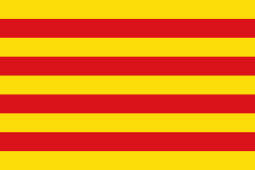The flag of Catalonia, which is called Senyera, consists of four red bars on a golden background.
It is also the official flag of some autonomous communities of Spain: Aragon, Balearic Islands, and Valencia; and the historically Catalan-speaking city of Alghero in Sardinia, Italy.
In addition, it is part of the flags of two regions in France: Languedoc-Roussillon, and Provence-Alpes-Côte d'Azur; and it is a quarter of the coat of arms of Andorra.
It is also the flag, or part of it, of many municipalities and divisions of the aforementioned territories. These, indeed, were part of the Crown of Aragon, which was ruled by the Count of Barcelona. Most of these lands speak Catalan. In fact, the flag is generally used to represent the Catalan language.
It is one of the oldest flags in Europe. It first appeared in the arms of the tomb of Ramon Berenguer II, Count of Barcelona, who died in 1082; and on a seal by Ramon Berenguer IV, Count of Barcelona, in 1150.
There is a song whose title is "El Cant de la Senyera" ("Song of the Senyera" in Catalan), which was composed by Lluís Millet and based on a poem by Joan Maragall. The song was composed to be the anthem of the Orfeó Català, a Catalan choral group. In 1896, it debuted at Montserrat in a ceremony in honor of the flag.
"El Cant de la Senyera" serves as a de facto anthem of Catalonia, even though "Els Segadors" is the official one.
There is a song whose title is "El Cant de la Senyera" ("Song of the Senyera" in Catalan), which was composed by Lluís Millet and based on a poem by Joan Maragall. The song was composed to be the anthem of the Orfeó Català, a Catalan choral group. In 1896, it debuted at Montserrat in a ceremony in honor of the flag.
"El Cant de la Senyera" serves as a de facto anthem of Catalonia, even though "Els Segadors" is the official one.

No comments:
Post a Comment